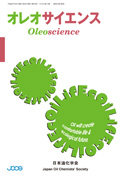
- |<
- <
- 1
- >
- >|
-
[in Japanese]2024Volume 24Issue 3 Pages 92
Published: 2024
Released on J-STAGE: March 06, 2024
JOURNAL FREE ACCESSDownload PDF (477K)
-
Hiroki ITABASHI, Shiki YAGAI2024Volume 24Issue 3 Pages 93-100
Published: 2024
Released on J-STAGE: March 06, 2024
JOURNAL FREE ACCESSCatenanes, a class of interlocked compounds wherein cyclic molecules are interlaced through mechanical bonds, have garnered considerable interest as nanomaterials, owing to their distinctive properties arising from the considerable mobility of constituent rings. Efficient synthesis of catenanes is achievable through the "template synthesis method," where precursors of cyclic molecules are arranged via specific noncovalent interactions. In contrast, our research group has pioneered the development of "nanocatenanes," wherein the constituent ring comprises not a single molecule, but an assemblage of several hundred molecules (nanoring). We have successfully visualized chain-like mesoscale structures of nanocatenanes utilizing atomic force microscopy. The construction of nanocatenanes is facilitated by secondary nucleation, a process in which the nucleation of subsequent nanoring is accelerated on the surface of existing nanorings. This article presents an overview of our exploration of nanocatenanes including details of the experimental verification of secondary nucleation and the control over the degree of nanocatenation by constricting the inner diameter of the nanorings through molecular design. Our studies demonstrate the feasibility of structural control within the mesoscale regime, bridging the gap between nanoscale and microscale, an achievement previously unattainable with traditional nanotechnological approaches.
 graphical abstract Fullsize ImageView full abstractDownload PDF (3203K)
graphical abstract Fullsize ImageView full abstractDownload PDF (3203K) -
Kenichi INOUE, Tsuyohito ITO, Yoshiki SHIMIZU, Yukiya HAKUTA, Kazuo TE ...2024Volume 24Issue 3 Pages 101-109
Published: 2024
Released on J-STAGE: March 06, 2024
JOURNAL FREE ACCESSAlthough flexible and thermally conductive composite materials are required for applications in flexible devices, there is generally a trade-off relationship between the thermal conductivity and the mechanical properties such as flexibility and toughness. It is also difficult to achieve composites combing these properties with high value. Here, this paper reviews tough-composites resolving this issue by utilizing cross-linking network composed of slide-ring polymers and plasma surface modification for filler dispersion. Uniform dispersion of fillers enabled the movable cross-linking points to enhance pulley effects which could result in relaxation of stress concentration around fillers to suppress embrittlement of composites. These approaches achieved tough composites, which combine flexibility and toughness. Moreover, filler alignment by electric fields in order to form thermally conductive pathway is also introduced, as a way to achieve tough-composites with a metal-class thermal conductivity and a rubber-class flexibility.
 graphical abstract Fullsize ImageView full abstractDownload PDF (2956K)
graphical abstract Fullsize ImageView full abstractDownload PDF (2956K) -
Kenji YAMAOKA, Naoki YAMASHITA, Ryohei IKURA, Yoshinori TAKASHIMA2024Volume 24Issue 3 Pages 111-118
Published: 2024
Released on J-STAGE: March 06, 2024
JOURNAL FREE ACCESSSelf-healing is a materials function to repair its structure and function from damage, either spontaneously or in response to stimuli. We succeeded in adding self-healing properties to polymeric materials by introducing two types of supramolecular network structures. Reversible cross-link forms with a host-guest inclusion complex, which can repeatedly associate and dissociate. The self-healing materials were reattached to the cut surface and recovered their original mechanical properties. Movable cross-link is a one of topological cross-link in which the polymer chain penetrates the cavity of cyclic molecules. The sliding motion of the cross-linking point with deformation resulted in high toughness and self-restoration. These supramolecular network structures improve the lifetime of polymeric materials by adding toughness and self-healing properties, thereby reducing the amount of petroleum-based polymeric materials would realize a circular economy.
 graphical abstract Fullsize ImageView full abstractDownload PDF (5522K)
graphical abstract Fullsize ImageView full abstractDownload PDF (5522K)
-
Akihiro Moriuchi, Matsuhiro Hori, Ryo Koike2024Volume 24Issue 3 Pages 119-122
Published: 2024
Released on J-STAGE: March 06, 2024
JOURNAL FREE ACCESSDownload PDF (1327K)
- |<
- <
- 1
- >
- >|